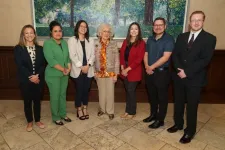(Press-News.org) Harmful diagnostic errors may be occurring in as many as 1 in every 14 (7%) hospital patients—at least those receiving general medical care—suggest the findings of a single centre study in the US, published online in the journal BMJ Quality & Safety.
Most (85%) of these errors are likely preventable and underscore the need for new approaches to improving surveillance to avoid these mistakes from happening in the first place, say the researchers.
Previously published reports suggest that current trigger tools for picking up medical mistakes aren’t good enough to detect harmful diagnostic errors, including those with less severe outcomes, suggest the researchers.
They therefore developed and validated a structured case review process to enable clinicians to interrogate the electronic health record (EHR) to evaluate the diagnostic process for hospital patients, assess the likelihood of a diagnostic error, and characterise the impact and severity of harm.
They used the process to estimate retrospectively the prevalence of harmful diagnostic errors in a randomly selected sample of 675 hospital patients out of a total of 9147 in receipt of general medical care between July 2019 and September 2021, excluding the height of the COVID-19 pandemic (April-December 2020).
Cases deemed to be at high risk of diagnostic error were categorised as: transfer to intensive care 24 or more hours after admission (130; 100%); death within 90 days of admission either in hospital or after discharge (141; 38.5%); complex clinical issues, but no transfer to intensive care or death within 90 days of admission (298; 7%).
Complex clinical issues included clinical deterioration; treatment by several different medical teams; unexpected events, such as cancelled surgery; unclear or discrepant diagnostic information recorded in the medical notes.
Cases deemed to be at low risk were those fulfilling none of the high risk criteria (106; 2.5%).
Each case was reviewed by two adjudicators trained to judge the likelihood of diagnostic error and identify associated process failures using the Diagnostic Error Evaluation and Research Taxonomy modified for acute care.
Harm was classified as minor, moderate, severe, and fatal, and whether the diagnostic error contributed to the harm and whether it was preventable were also assessed.
Cases with discrepancies or uncertainty about the diagnostic error or its impact were further reviewed by an expert panel.
Among all the cases reviewed, diagnostic errors were found in 160 cases (154 patients). These comprised: intensive care transfer (54); death within 90 days (34); complex clinical issues (52); low risk patients (20).
Harmful diagnostic errors were assessed to have occurred in 84 cases (82 patients), of which 37 (28.5%) occurred among intensive care transfers; 18 (13%) among those who died within 90 days; 23 (8%) among those with complex clinical issues; and 6 (6%) in low risk cases.
Harm severity was characterised as minor in 5 (6%), moderate in 36 (43%), major in 25 (30%) and fatal in 18 (21.5%).
In all, an estimated 85% of harmful diagnostic errors were preventable, with older, White, non-Hispanic, non-privately insured and high-risk patients most at risk.
Weighted to take account of the population, the researchers estimated the proportion of harmful, preventable, and severely harmful diagnostic errors in general medical hospital patients to be just over 7%, 6%, and 1%, respectively.
Process failures were significantly associated with diagnostic errors, particularly uncertainty in initial assessments and complex diagnostic testing and interpretation (4 times the risk), suboptimal subspecialty consultation (3 times the risk), concerns reported by patients (3 times the risk) and history taking (2.5 times the risk).
Forty (48%) diagnostic errors were related to the primary diagnosis at admission or discharge and 44 (52.5%) to a secondary diagnosis. Fifty two (62%) were characterised as delays. Errors associated with major or fatal harm were frequent in the high risk group (55%, 43/78) and rare in the low risk group (0/6).
The most frequent diagnoses associated with diagnostic errors included heart failure, acute kidney failure, sepsis, pneumonia, respiratory failure, altered mental state, abdominal pain and hypoxaemia (low blood oxygen levels).
Careful analysis of the errors and integrating AI tools into the workflow should help to minimise their prevalence, by improving monitoring and triggering timely interventions, suggest the researchers.
This is an observational study, based on estimates, drawn from data on patients receiving general medical care at one single centre, and should be interpreted in that context, caution the researchers.
They also acknowledge that the sample was restricted to patients with a length of hospital stay under 21 days, and that the study relied on information captured in the electronic health record, which is prone to inaccurate recording of deaths within 90 days.
Nevertheless, they conclude: “We estimate that a harmful [diagnostic error] occurred in 1 of every 14 patients hospitalised on general medicine, the majority of which were preventable. Our findings underscore the need for novel approaches for adverse [diagnostic error] surveillance.”
END
Harmful diagnostic errors may occur in 1 in every 14 general medical hospital patients
Most preventable, underscoring need for new approaches to surveillance, say researchers
2024-10-01
ELSE PRESS RELEASES FROM THIS DATE:
Closer look at New Jersey earthquake rupture could explain shaking reports
2024-10-01
The magnitude 4.8 Tewksbury earthquake surprised millions of people on the U.S. East Coast who felt the shaking from this largest instrumentally recorded earthquake in New Jersey since 1900.
But researchers noted something else unusual about the earthquake: why did so many people 40 miles away in New York City report strong shaking, while damage near the earthquake’s epicenter appeared minimal?
In a paper published in The Seismic Record, YoungHee Kim of Seoul National University and colleagues show how the earthquake’s ...
Researchers illuminate inner workings of new-age soft semiconductors
2024-10-01
One of the more promising classes of materials for next-generation batteries and electronic devices are the organic mixed ionic-electronic conductors, OMIECs for short. These soft, flexible polymer semiconductors have promising electrochemical qualities, but little is known about their molecular microstructure and how electrons move through them – an important knowledge gap that will need to be addressed to bring OMIECs to market.
To fill that void, materials scientists at Stanford recently employed ...
University of Houston partners with Harris County to create a sustainable energy future
2024-10-01
University of Houston researchers are partnering with the Harris County Office of County Administration’s Sustainability Office, the Harris County Energy Management Team and other county staff to develop a comprehensive baseline of energy use and energy-use intensity for county’s assets. Once established, the baseline will enable the team to track progress and evaluate the effectiveness of energy-saving measures over time, laying the groundwork for programs aimed at reducing energy consumption, maximizing savings, and increasing the use of renewable and resilient ...
Looking deeper into the mirror
2024-10-01
A team of Canadian and American scientists has made a promising breakthrough in understanding the origins of a mysterious neurological disorder known as mirror movements.
The discovery was made by Kaiyue Zhang, a doctoral student at the Montreal Clinical Research Institute (IRCM), affiliated with Université de Montréal, and by Karina Chaudhari, a doctoral student at the University of Pennsylvania.
As co-first authors, they published their study today in the journal Science Signaling.
They were led by Frédéric Charron, an UdeM research professor ...
Friends of BrainHealth donor circle awards coveted grants to fuel innovative research
2024-10-01
The 2024 Ramona Jones Friends of BrainHealth Luncheon on September 30, 2024 continued the 25th anniversary celebration of Center for BrainHealth – part of The University of Texas at Dallas – and the second year this annual event has been sponsored by founding Advisory Board member Ramona Jones and her family.
Staged “Shark Tank”-style” at the Dallas Country Club, the event featured a competition between emerging scientists pitching novel research proposals and vying for $20,000 in seed funding. Event co-chair Nikki Kapioltas opened the event, calling attention to a milestone ...
Study of infertility, health among women of Mexican heritage funded by $2.2M NIH grant
2024-10-01
Researchers at the University of Arizona Health Sciences and the Instituto Nacional de Salud Pública in Mexico are using a $2.2 million National Institutes of Health grant to explore the link between infertility and long-term health issues among Hispanic women of Mexican heritage.
According to recent research, female infertility is often associated with greater risks of cancer, cardiovascular disease and premature mortality. Hispanic women are up to 70% more likely to experience infertility than white women, yet little is known about their long-term health.
“Hispanics are the largest minority group in the United States, and 60% of Hispanics have Mexican heritage. ...
Airborne plastic chemical levels shock researchers
2024-10-01
A new study documents how Southern Californians are chronically being exposed to toxic airborne chemicals called plasticizers, including one that’s been banned from children’s items and beauty products.
Plasticizers are chemical compounds that make materials more flexible. They are used in a wide variety of products ranging from lunchboxes and shower curtains to garden hoses and upholstery.
“It’s not just for drinking straws and grocery bags,” said David Volz, environmental sciences professor at UC Riverside, ...
DOD awards $9M for snowpack and meltwater research and Arctic training program in Alaska and New England
2024-10-01
The Department of Defense (DOD) has awarded a $9 million contract to the University of Maine for research that will significantly expand efforts to quantify snowpack properties, explore the impact of snowmelt on the surrounding terrestrial environments of Alaska and Maine, and expand training opportunities in polar science.
The project is led by School of Earth and Climate Sciences and Climate Change Institute faculty member Seth Campbell, who will collaborate with more than a dozen other scientists from UMaine and other institutions. The effort builds on a related and existing ...
SETI Institute awards education grant through the STRIDE program
2024-10-01
SETI Institute Awards Education Grant through the STRIDE Program
October 1, 2024, Mountain View, CA – The SETI Institute awarded its first education grant through its Support Technology, Research, Innovation, Development and Education (STRIDE) program. The grant supports a new project called Encountering Stars in an Inflatable Planetarium, which will offer immersive astronomy and astrobiology experiences for elementary and middle school students in low-income areas and high school and adult audiences interested in STEM-related experiences. The program also includes a training workshop for K-12 teachers ...
NYU Historian Jennifer L. Morgan wins 2024 MacArthur “Genius Grant”
2024-10-01
New York University historian Jennifer L. Morgan, whose work focuses on the institutionalization of race-based slavery in early America and the Black Atlantic, has been named a 2024 MacArthur Fellow by the John D. and Catherine T. MacArthur Foundation.
MacArthur Fellows are recipients of the foundation’s “genius grants,” who each receive $800,000 over a five-year period to pursue intellectual, social, and artistic endeavors.
“The 2024 MacArthur Fellows pursue rigorous inquiry with aspiration and purpose,” says MacArthur Fellows Director ...
LAST 30 PRESS RELEASES:
Numbers in our sights affect how we perceive space
SIMJ announces global collaborative book project in commemoration of its 75th anniversary
Air pollution exposure and birth weight
Obstructive sleep apnea risk and mental health conditions among older adults
How talking slows eye movements behind the wheel
The Ceramic Society of Japan’s Oxoate Ceramics Research Association launches new international book project
Heart-brain connection: international study reveals the role of the vagus nerve in keeping the heart young
Researchers identify Rb1 as a predictive biomarker for a new therapeutic strategy in some breast cancers
Survey reveals ethical gaps slowing AI adoption in pediatric surgery
Stimulant ADHD medications work differently than thought
AI overestimates how smart people are, according to HSE economists
HSE researchers create genome-wide map of quadruplexes
Scientists boost cell "powerhouses" to burn more calories
Automatic label checking: The missing step in making reliable medical AI
Low daily alcohol intake linked to 50% heightened mouth cancer risk in India
American Meteorological Society announces Rick Spinrad as 2026 President-Elect
Biomass-based carbon capture spotlighted in newly released global climate webinar recording
Illuminating invisible nano pollutants: advanced bioimaging tracks the full journey of emerging nanoscale contaminants in living systems
How does age affect recovery from spinal cord injury?
Novel AI tool offers prognosis for patients with head and neck cancer
Fathers’ microplastic exposure tied to their children’s metabolic problems
Research validates laboratory model for studying high-grade serous ovarian cancer
SIR 2026 delivers transformative breakthroughs in minimally invasive medicine to improve patient care
Stem Cell Reports most downloaded papers of 2025 highlight the breadth and impact of stem cell research
Oxford-led study estimates NHS spends around 3% of its primary and secondary care budget on the health impacts of heat and cold in England
A researcher’s long quest leads to a smart composite breakthrough
Urban wild bees act as “microbial sensors” of city health.
New study finds where you live affects recovery after a hip fracture
Forecasting the impact of fully automated vehicle adoption on US road traffic injuries
Alcohol-related hospitalizations from 2016 to 2022
[Press-News.org] Harmful diagnostic errors may occur in 1 in every 14 general medical hospital patientsMost preventable, underscoring need for new approaches to surveillance, say researchers





